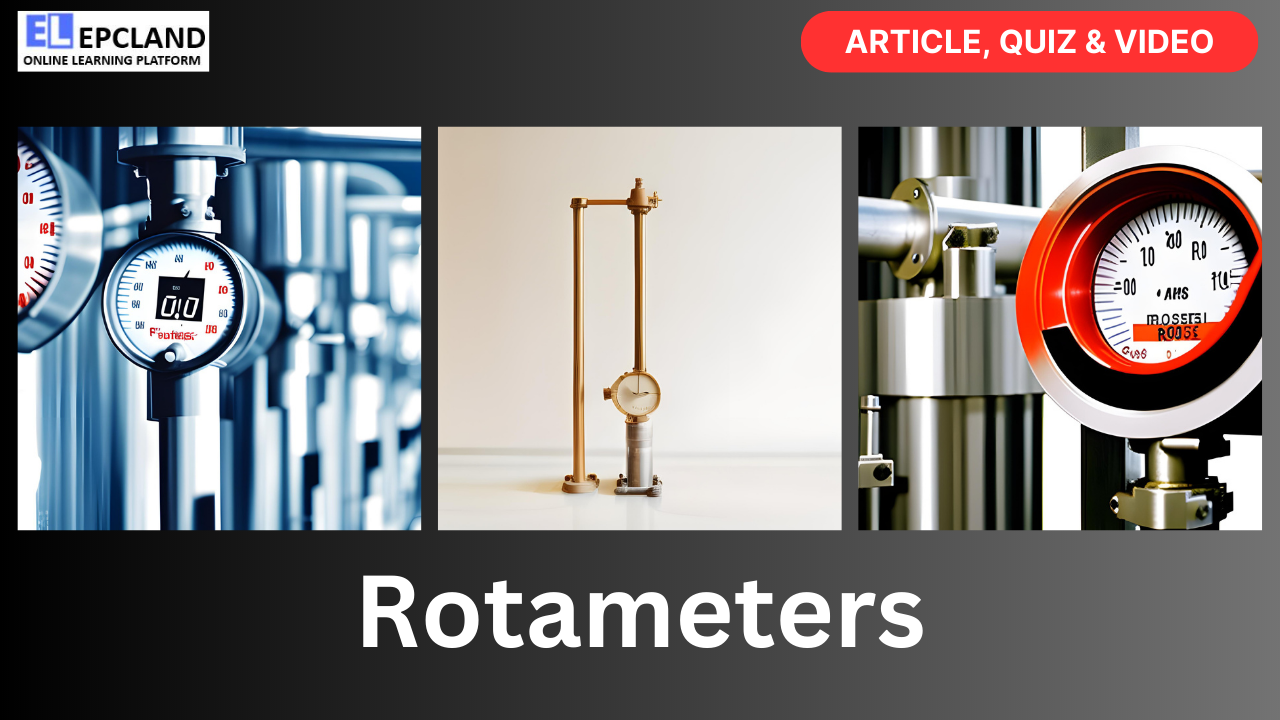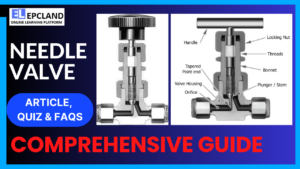The Oil and Gas Industry is a vast and intricate sector, involving numerous processes and technologies to ensure the efficient production, transportation, and processing of hydrocarbons. One such technology that plays a crucial role in this industry is the Rotameter. In this comprehensive guide, we will delve into the world of Rotameters, exploring their principles, applications, benefits, challenges, and a table summarizing their advantages and disadvantages within the context of oil and gas projects.
Table of Contents
Do not miss the detailed course 7 Modules of Piping Codes & Standards
Enrollment link
Introduction to Rotameters
What is a Rotameter?
A Rotameter, also known as a variable area flowmeter or a float meter, is a simple yet effective device used for measuring the flow rate of fluids, particularly gases and liquids, in industrial processes. It consists of a tapered tube with a float (often spherical or conical) that moves vertically within the tube as the fluid flows through it. The position of the float within the tube provides a visual indication of the flow rate.
The Principle of Operation
The operation of a Rotameter is based on the principle of variable area flow measurement. As the fluid flows upward through the tapered tube, the increasing cross-sectional area allows the float to move upward. The gravitational force on the float is balanced by the buoyant force of the fluid, resulting in a stable position within the tube. The height of the float above its lowest point is directly proportional to the flow rate. This height can be calibrated to provide a flow rate reading in engineering units (e.g., liters per minute or cubic feet per hour).
Applications of Rotameters in the Oil and Gas Industry
Rotameters find extensive use in various aspects of the Oil and Gas Industry due to their simplicity, reliability, and ability to handle a wide range of flow rates and fluids. Some key applications include:
1. Chemical Injection Systems
In oil and gas production, chemicals are often injected into wells and pipelines to facilitate processes such as corrosion inhibition, scale prevention, and enhanced oil recovery. Rotameters are employed to measure and control the precise injection rates of these chemicals.
2. Hydrocarbon Measurement
Rotameters are used to measure the flow rates of hydrocarbons in pipelines and production facilities. They play a critical role in custody transfer applications, ensuring accurate measurement for billing purposes and compliance with regulatory standards.
3. Gas Flow Measurement
In gas processing plants and distribution systems, Rotameters are utilized to measure the flow rates of natural gas, hydrogen, and other gases. They provide reliable readings for process control and monitoring.
4. Well Testing
During well testing operations, Rotameters help monitor and control the flow rates of oil, gas, and water produced from wells. This data is essential for reservoir analysis and production optimization.
5. Laboratory and Research
In research and laboratory environments within the industry, Rotameters are used for various fluid flow experiments, calibration procedures, and equipment testing due to their accuracy and ease of use.
Benefits of Using Rotameters
Rotameters offer several advantages that make them a preferred choice in many oil and gas applications:
1. Visual Flow Rate Indication
One of the primary benefits of Rotameters is their ability to provide a direct visual indication of flow rate. This feature allows operators to quickly assess whether the flow is within the desired range.
2. Simplicity and Reliability
Rotameters have a straightforward design with no moving parts except for the float. This simplicity enhances their reliability and reduces the risk of mechanical failures, making them suitable for harsh industrial environments.
3. Wide Range of Flow Rates
Rotameters are available in various sizes and can measure a wide range of flow rates, from a few milliliters per minute to thousands of liters per minute, making them versatile for different applications.
4. Compatibility with Various Fluids
Rotameters can handle a broad range of fluids, including corrosive, abrasive, and high-temperature substances. The choice of materials for the tube and float can be customized to suit specific applications.
5. Low Maintenance
Due to their simplicity and lack of complex components, Rotameters require minimal maintenance. Routine inspection and cleaning are typically sufficient to keep them in optimal working condition.
Challenges and Considerations
While Rotameters offer numerous benefits, they also come with certain limitations and considerations, especially in demanding oil and gas applications:
1. Pressure and Temperature Limits
Rotameters may have limitations regarding the pressure and temperature of the fluid being measured. For high-pressure or high-temperature applications, alternative flow measurement technologies may be more suitable.
2. Accuracy
The accuracy of Rotameters can be affected by changes in fluid properties, such as viscosity and density. Calibration and periodic verification are essential to maintain accuracy.
3. Limited Turndown Ratio
Rotameters may have a limited turndown ratio, which is the range between the minimum and maximum flow rates they can accurately measure. In applications with wide variations in flow, multiple Rotameters or alternative flow measurement devices may be required.
4. Fluid Compatibility
Selecting the appropriate materials for the Rotameter tube and float is crucial to ensure compatibility with the fluid being measured. Corrosive or abrasive fluids may require specialized materials.
5. Installation and Mounting
Proper installation, including vertical mounting and adequate straight pipe lengths before and after the Rotameter, is essential to ensure accurate readings.
Do not miss the detailed course 7 Modules of Piping Codes & Standards
Enrollment link
Advantages and Disadvantages of Rotameters
Let’s summarize the advantages and disadvantages of using Rotameters in the table below:
| Advantages | Disadvantages |
|---|---|
| Visual flow rate indication | Pressure and temperature limitations |
| Simplicity and reliability | Accuracy affected by fluid properties |
| Wide range of flow rates | Limited turndown ratio |
| Compatibility with various fluids | Fluid compatibility considerations |
| Low maintenance | Installation requirements |
Innovations and Advancements
Rotameters have evolved over the years, with advancements in materials, design, and technology to meet the evolving needs of the oil and gas industry. Some notable innovations include:
1. Digital Rotameters
Digital Rotameters incorporate electronic sensors and displays to provide precise digital readings of flow rates. These devices offer improved accuracy and remote monitoring capabilities.
2. Coriolis Mass Flow Meters
Coriolis mass flow meters have gained popularity in the industry for their high accuracy and ability to measure mass flow directly. They are often used in applications where mass measurement is critical.
3. Multiphase Flow Meters
Multiphase flow meters have been developed to measure the flow rates of oil, gas, and water in multiphase flow conditions commonly encountered in production wells. These meters are highly specialized and offer advanced measurement capabilities.
Conclusion
Rotameters, with their simple yet effective design, have proven to be valuable tools in the Oil and Gas Industry. Their ability to measure flow rates of gases and liquids reliably and visually makes them suitable for a wide range of applications, from chemical injection systems to custody transfer measurements.
However, it’s crucial to consider the specific requirements and challenges of each application when selecting a flow measurement device. While Rotameters offer many benefits, they may not be the best choice for all scenarios. As technology continues to advance, the industry will have access to even more accurate and versatile flow measurement options to meet its evolving needs.
In conclusion, Rotameters remain a fundamental instrument in the Oil and Gas Industry, providing essential flow rate data that is integral to the success and efficiency of various processes within this critical sector. As the industry continues to innovate and adapt to new challenges, Rotameters will likely remain a valuable and trusted tool in the toolbox of professionals working in oil and gas projects.
FAQs
1. What is the operating principle of a Rotameter?
- A Rotameter operates on the principle of variable area flow measurement. It consists of a tapered tube with a float that moves vertically within it as fluid flows through. The height of the float within the tube provides a visual indication of the flow rate, and this height is directly proportional to the flow rate.
2. What are the primary advantages of using Rotameters in oil and gas applications?
- Rotameters offer several advantages, including visual flow rate indication, simplicity and reliability, suitability for a wide range of flow rates and fluids, compatibility with various fluids, and low maintenance requirements.
3. What are the limitations of Rotameters in the oil and gas industry?
- Some limitations of Rotameters include pressure and temperature limitations, potential accuracy issues with changes in fluid properties, limited turndown ratio in some cases, considerations regarding fluid compatibility, and specific installation requirements.
4. How are Rotameters calibrated, and how often should they be calibrated?
- Rotameters are typically calibrated using standardized procedures and equipment. The frequency of calibration depends on the application, but it is generally recommended to calibrate them periodically, such as annually or whenever there is a significant change in operating conditions.
5. What are some alternatives to Rotameters for flow measurement in the oil and gas industry?
- Alternative flow measurement devices in the industry include Coriolis mass flow meters, electromagnetic flow meters, ultrasonic flow meters, and vortex flow meters. The choice of the most suitable device depends on factors such as accuracy requirements, fluid properties, and operating conditions.
Do not miss the detailed course 7 Modules of Piping Codes & Standards
Enrollment link
Recommended courses (Published on EPCLand)
- Basics of Piping Engineering
- Piping Layout Engineering
- Piping Material Engineering
- Piping Stress Analysis
- Complete Course on Piping Engineering
- Material Requisitions
- Piping Material Specifications
- Valve Material Specifications
Don’t miss the published articles on following:
Related Video
Attempt Quiz
Question 1:
What is the primary purpose of rotameters in oil & gas projects?
Explanation: Rotameters in oil & gas projects are primarily used to measure fluid flow rates in pipelines and processes.
Question 2:
What is the typical design of a rotameter?
Explanation: A typical rotameter consists of a glass tube with a float that rises or falls to indicate the fluid flow rate.
Question 3:
Why are rotameters preferred for certain applications in the oil & gas industry?
Explanation: Rotameters are preferred in some applications because they provide a visual indication of flow and are relatively inexpensive.
Question 4:
What is the significance of the float’s position in a rotameter?
Explanation: The position of the float in a rotameter indicates the fluid flow rate through the tube.
Question 5:
What type of fluids can be measured using rotameters in oil & gas applications?
Explanation: Rotameters can measure both gases and liquids in oil & gas applications.



